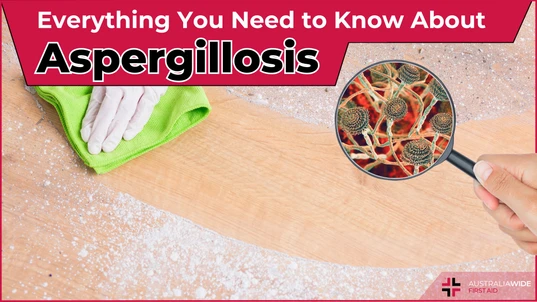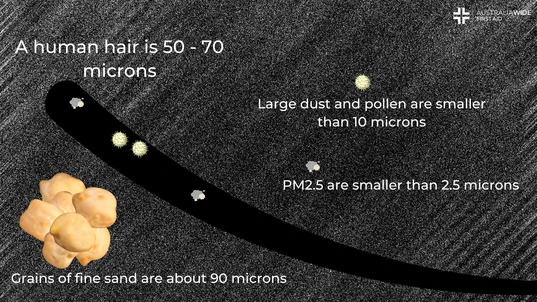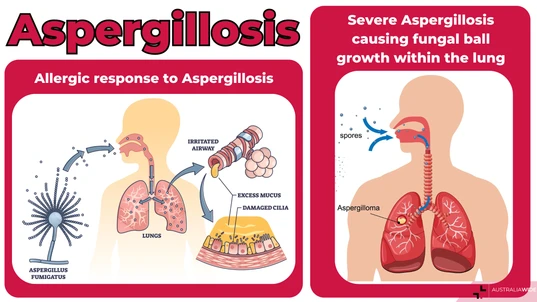Everything You Need to Know About Aspergillosis

Disease
 Although the term Aspergillosis may sound like a tongue twister, it's something that all Australians should be aware of, particularly given our warm, humid atmosphere which is ideal for the formation of mould. This bothersome infection, which is brought on by the common mould Aspergillus, can be rather serious, especially for people who have compromised immune systems or respiratory problems. But don't worry—you’ve come to the right place. In this article we will go over everything you need to know about Aspergillosis, what causes it, the symptoms, treatment options as well as first aid procedures for this type of exposure.
Although the term Aspergillosis may sound like a tongue twister, it's something that all Australians should be aware of, particularly given our warm, humid atmosphere which is ideal for the formation of mould. This bothersome infection, which is brought on by the common mould Aspergillus, can be rather serious, especially for people who have compromised immune systems or respiratory problems. But don't worry—you’ve come to the right place. In this article we will go over everything you need to know about Aspergillosis, what causes it, the symptoms, treatment options as well as first aid procedures for this type of exposure.
What Is Aspergillosis?
In short, Aspergillosis is an infection brought on by the mould Aspergillus, which is frequently found in our surroundings—whether it be in plants, soil, or even dust. While the majority of people can come into contact with this mould without any concerns, those who already have lung ailments or compromised immune systems may be at risk of experiencing more serious health complications. That said, being aware of Aspergillosis is crucial for safeguarding your health, particularly in areas like Australia where the weather can promote the growth of mould.
Causes of Aspergillosis
Aspergillus, a form of fungus that is frequently found in our surroundings, grows best in environments with lots of organic matter, such as dust in homes, soil, decomposing leaves, and compost. It is also commonly found in areas with warm, humid air, which are circumstances that are widespread throughout much of Australia. Since the immune system is strong enough to ward off these invaders, breathing in Aspergillus spores usually has no negative health effects on the body. But occasionally, these spores can take hold and cause infection, particularly in people with compromised immune systems, those who already have lung disorders like COPD or asthma, or those receiving therapies that compromise immune function. Aspergillosis can take on several forms based on the body's reaction to the spores. As an example, Allergic Bronchopulmonary Aspergillosis or ABPA is a lung inflammation caused by the immune system's reaction to the spores. In more serious situations, the infection may spread from the lungs to other areas of the body, a condition known as invasive Aspergillosis. For that reason, it is essential to understand the causes of Aspergillosis in order to reduce risk, especially in areas where exposure to mould is more probable. The danger of contracting Aspergillosis can be considerably decreased by keeping your living area dry and clean, especially in areas where mould growth is common.
Symptoms of Aspergillosis
If someone has Aspergillosis, their symptoms can be very different based on the type of infection they have and their overall health. If you are exposed to Aspergillus mould and your immune system is healthy, you might not even notice any signs. That said, Aspergillosis can show up in different ways in people whose immune systems are weak or who have lung diseases or other underlying health problems. The most prevalent symptoms are those associated with asthma or other allergic responses. Some of these symptoms include wheezing, shortness of breath, coughing, and overall chest tightness. People with ABPA may also cough up mucus or, in some situations, small amounts of blood. In more dangerous cases, like invasive Aspergillosis, the symptoms are worse and can include fever, chest pain, and trouble breathing. This particular form of Aspergillosis can occur when an infection from the lungs spreads to other organs, such as the liver, kidneys, or even the brain. Aspergillosis can also show up as a sinus infection, with signs like stuffy nose, facial pain, and headaches. That said, early detection of these signs is important for getting the right treatment and stopping the infection from getting worse.
Treatment Options for Aspergillosis
Aspergillosis can be treated in different ways, depending on the severity. For allergic types, such as ABPA, the main goal is usually to control the allergic reaction and lower the inflammation in the lungs. This is usually done with Corticosteroids to help lower inflammation, and antifungal medications. When an illness gets worse, like with invasive Aspergillosis, it spreads from the lungs to other parts of the body and needs quick and effective treatment. Antifungal medicine is the most important part of treating invasive Aspergillosis. Medications like Voriconazole are also often recommended. In some cases, surgery may be needed, especially when Aspergillosis forms a "fungal ball" in the lungs, which is called an "Aspergilloma." It may be especially important if the Aspergilloma is causing a lot of pain or is likely to lead to more serious problems, like bleeding. Aspergillosis must be diagnosed and treated as soon as possible for it to be managed well. Regular monitoring and proactive treatment can help keep infections from getting worse in people whose immune systems aren't strong enough or who already have existing health problems.
Special Considerations
In the context of Aspergillosis, certain individuals must exercise heightened caution. Individuals with compromised immune systems, such as those who have undergone organ transplantation, cancer patients receiving chemotherapy, or those with persistent respiratory disorders like asthma or COPD, face an increased susceptibility to serious consequences. In such instances, even low-level contact with Aspergillus mould might result in severe health complications. In light of this, it is very important for these individuals to take extra steps, such as staying away from places where mould is likely to grow and quickly visiting a doctor if signs appear.First Aid Procedures for Aspergillosis Exposure
It's very important to act quickly if you think you or someone you know may have been exposed to Aspergillus mould and notice any signs such as excessive coughing, hacking, or having trouble breathing. First, get to a clean, well-ventilated space to avoid more contact. If symptoms persist or worsen, especially in individuals with existing lung conditions or weakened immune systems, it’s best to consult a GP or book a telehealth consultation. A doctor can assess your risk and recommend the appropriate treatment. If you have access to them, give any recommended inhalers or medicines. If you do have a pre-existing ailment, it is always advised to consult your doctor about how to prevent or treat this exposure if it occurs. In this manner, you may calmly handle the situation and be as ready as possible.
Originally published at
https://www.australiawidefirstaid.com.au/resources/everything-you-need-to-know-about-aspergillosis
as part of the Australia Wide First Aid Articles Library









